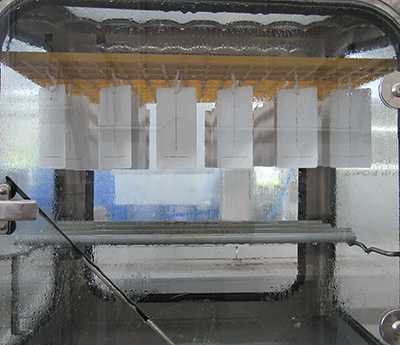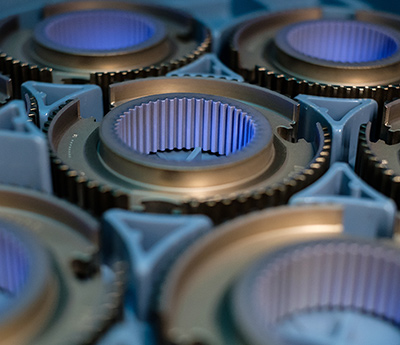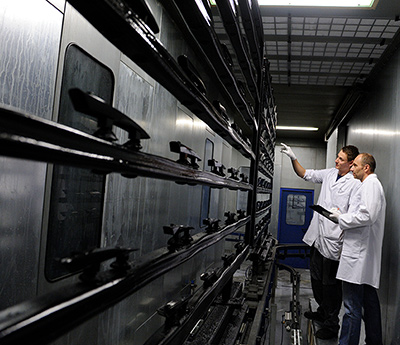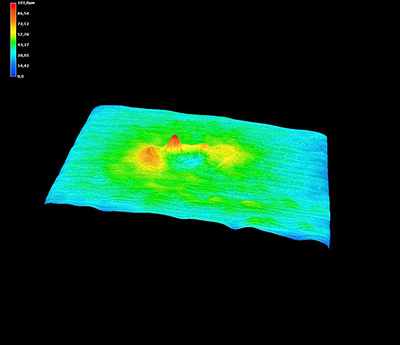DEVELOPMENT
The right solution for your product
As one of the leading companies in the field of surface and coating technology, we offer tailor-made solutions for your components. Regardless of whether it’s for technical coating or visual enhancement, our experts work with you, our suppliers, plant manufacturers and research institutes to find exactly the right solution for your project
We use our versatile coating options as well as our in-house laboratory to provide you with a wide range of possible solutions. You can then decide for yourself whether we should only do the development work for you or whether we also take on the entire series production. Our development services cover the complete process chain of surface finishing including pre-treatment and the coating technology. These include, for example:
Surfaces with special technical and visual properties
Deep black or brightly coloured, non-slip or especially slippery. Durable protection or temporary functional coating. Coatings today have to meet the most varied demands and at the same time be specially adapted to the substrate and the component.
Corrosion protection on metals
One of the most important tasks of coatings on metals is to provide corrosion protection. Each industrial sector has its own requirements. In the automotive industry, for example, outdoor corrosion by de-icing salt is an important issue. But even for components used indoors, such as coffee machines, protection against corrosion by environmental influences and everyday use is important.
Coatings on particularly complicated substrates as well as on components with special geometries
Novel materials with special properties have now become indispensable for many industrial sectors. In order to protect these materials from the effects of the weather or to furnish them with a visually appealing surface, it is becoming increasingly necessary to use special coating systems with optimised application methods. In addition, geometries are becoming more complex and require a highly developed coating process.
Pre-treatment processes
Often the components are actually contaminated by the previous processing. This is especially true for oils and fats, although other residues can also have a negative impact on further processing. Using the right pre-treatment processes, the components can be freed of any damaging residues.
In addition, the right pre-treatment process can improve adhesion and increase corrosion protection. For special applications, the resulting protection may be enough to render any subsequent coating unnecessary.
Machines and equipment for pre-treatment and coating
In addition to the right coating, the right equipment is also key to ensuring a high-quality surface. Here, a variety of parameters play an important role and must be coordinated with one another. Today, coating by robots is in widespread use and offers the highest levels of reproducibility. But painting by hand still remains an important part of coating, especially for small series, prototypes and special components.
Laboratory
Our laboratory offers you a variety of test options:
Layer thickness measurements
The layer thickness of a coating has a great influence on parameters such as corrosion protection, mechanical strength or chemical resistance, in addition to levels of gloss or colour. For this reason we regularly measure the layer thicknesses of our coatings. The measuring instruments work according to the standards ISO 2360 and ISO 2178, using the eddy current principle. In addition, we can also determine layer thicknesses by ultrasound and in this way are able to determine each individually applied layer in a multi-layer application with only one measurement.
Neutral salt spraying
Using our DIN EN ISO 9227-compliant salt spray test, we can determine the corrosion resistance of a material or coating. During the test, the components are housed in a test chamber in which a controlled-pH 5% saline solution is continuously atomised at a temperature of approximately 35°C. The spray mist settles on the test samples and covers them with a corrosive salt-water film. Typical test durations may be 96 hours, 240 hours, 480 hours, 720 hours or even longer. The corrosive attack on the material system is then assessed visually. The corrosion resistance is derived from the time a test sample survives without corrosion beyond a defined threshold.
Condensate-constant climate
In the ISO 6270-2 CH-compliant condensate-constant climate test, water is heated to +40° C while an air humidity of 100% is maintained in a test chamber. This then condenses water vapour on the samples. Typical test durations nay be 240 hours, 510 hours, 1000 hours or even longer. Afterwards, the components are visually inspected. The condensate-constant climate test is mainly used to test the adhesion between the individual layers and particularly reveals problems with the pre-treatment of the components.
Spectrophotometry
Using our spectrometers, we can measure the colour of a surface with precise values in the colour space. We can use the ‘multiple angle’ and ‘spherical’ measuring methods so that a defined value can be obtained. In this way any differences in the hue can be precisely determined and thresholds can be set.
Gloss measurement
The gloss measurement according to DIN 67530 and ISO 2813 is carried out by illuminating the surface with a constant light source at a certain angle and measuring the light reflected. This produces a reflectance value as a measure of the gloss. The unit of measurement used is GU (Gloss Units).
Cleanliness measurement
By using fluorescence technology, the minutest traces of organic contaminants such as oils, greases or cooling lubricants can be detected. To this end, a reference component is first cleaned using a suitable medium and then measured against the test sample. The measurement result is expressed in cleanliness percentage. A cleanliness of 100% corresponds to an absolutely clean surface based on the reference component used for calibration. This measurement method can be used to evaluate cleaning processes, and also to carry out incoming goods inspections.
Other measurement methods
In addition to the measurement methods already described, other techniques are used for qualitatively assessing the coating layer. These include microscopy, hardness testing, light booths, scratch resistance testing, mandrel bending tests and many more.




